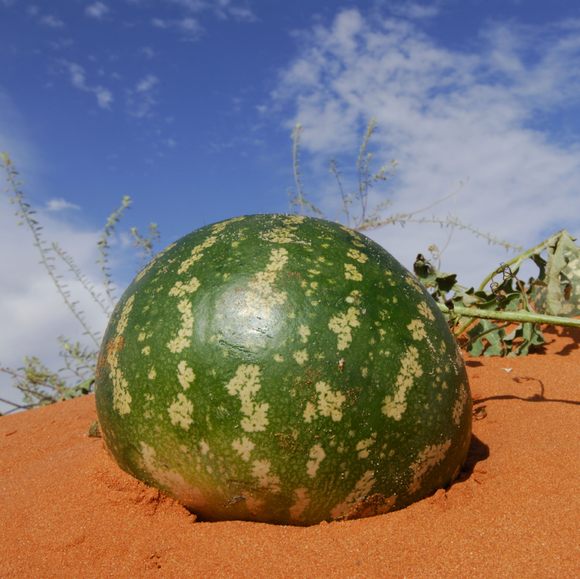Fruits & Vegetables
Tsamma Melon
This wild fruit helps man and beast survive long treks without water in the Kalahari desert.
For the hunter-gatherer San tribe of southern Africa, hunting season would be impossible without the hydration provided by the tsamma melon. It is of particular value to the San tribes in the Kalahari desert for its nutritious seeds and the high water content of its flesh. There is a belief that a person can survive for six weeks on nothing but the tsamma.
The tsamma is a type of watermelon belonging to the melon/gourd family that grows wild in most of western, central, and southern Africa. In Namibia, this perennial desert fruit is called Citrullus ecirrhosus, or Namib tsamma. Tsamma melons resemble watermelons on the outside, but have a pale flesh with black seeds. They can be vaguely sweet, but are mostly flavorless. And if you’ve just had a bitter tsamma, spit immediately, for those are poisonous.
David Livingstone, the celebrated 19th-century missionary and explorer, has written about encountering tribes in the arid interior regions of southern Africa along the Zambezi river, who survived on the desert melons for several months of the year when water was scarce.
The San use all parts of the tsamma: The flesh is dried and cooked into stews, while the seeds are considered very nutritive and can be roasted and eaten by themselves or ground into flour. Tsamma seed oil is used for cooking and as a body oil. Even the leaves of the melons can be cooked like spinach.
North Africa domesticated the tsamma hundreds of years ago. The fruit is typically pollinated by bees and flies and, once sown in the rainy season, it can start to germinate within a week. Man or beast, for dwellers of the Kalahari (which derives from the Tswana word kgala, meaning “great thirst,” or kgalagadi, meaning “waterless place”), the water-giving tsamma melon is an essential mode of survival.
Where to Try It
-
You can book a spot on the Nossob 4 x 4 Eco Trail, where a guide will drive along with you to highlight features of the park, which straddles Botswana and South Africa, including tsamma melons and the famous Kalahari black-maned lions. Call or email (ian.heyns@sanparks.org). The trail takes several days to complete.
Written By
 Rohini Chaki
Rohini Chaki
Sources
- books.google.com/books?id=0ZmRDQAAQBAJ&pg=PT2&dq=melon+a+global+history&hl=en&sa=X&ved=0ahUKEwjZiM2UkYzhAhUKhOAKHfY4DUcQ6AEIKDAA#v=onepage&q=tsamma&f=false
- www.fondazioneslowfood.com/en/ark-of-taste-slow-food/tsamma-melon/
- www.scientificamerican.com/article/dr-david-livingston-bicentenary/
- www.botanicalsociety.org.za/ProjectsAndActivities/Useful%20Plants/18%20Tsamma%20Melon%20March%202012.pdf
- www.sahistory.org.za/article/san
- books.google.com/books?id=5DeCCgAAQBAJ&pg=PA258&lpg=PA258&dq=david+livingstone+%22tsamma%22&source=bl&ots=tRZAnWZYnI&sig=ACfU3U2OeEQ4LrN5ErqCPK7X959Z6oG8lg&hl=en&sa=X&ved=2ahUKEwiuhbLfkYzhAhWBdd8KHUFgCggQ6AEwAXoECAgQAQ#v=onepage&q=david%20livingstone%20%22tsamma%22&f=false
- books.google.com/books?id=yQMdDgAAQBAJ&pg=PA251&lpg=PA251&dq=kgala+tswana&source=bl&ots=8PWJiLFq4M&sig=ACfU3U0R52W9WIoXatPdX5KUMmeSB9nPIg&hl=en&sa=X&ved=2ahUKEwiUoue0k4zhAhXsUd8KHYxKBsMQ6AEwCHoECAEQAQ#v=onepage&q=kgala%20tswana&f=false














